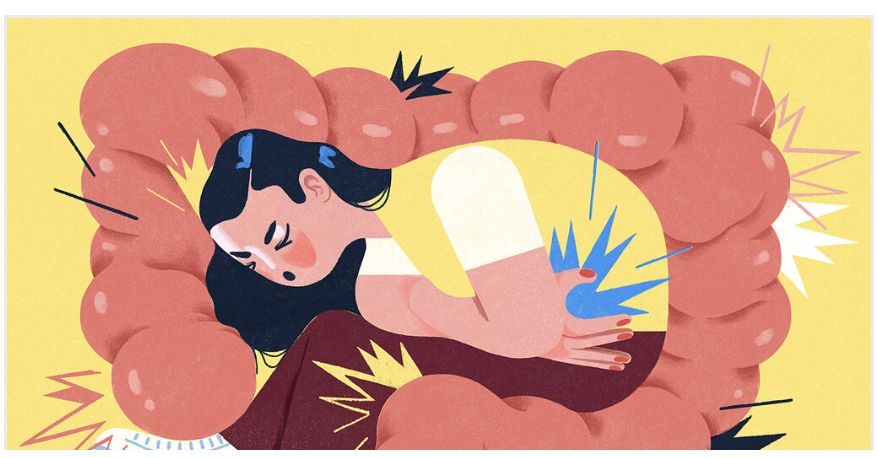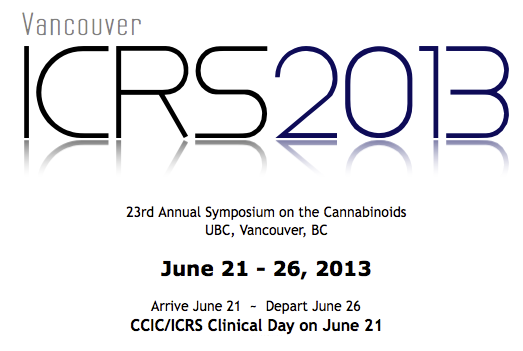Big Pharma had good reason to fund the neoprobes’ campaign to divert and choke off the medical marijuana movement. If US doctors had been routinely recommending cannabis instead of SSRIs like Zoloft to treat depression all these years, the bottom would have fallen out of the anti-depressant market. Instead, sales continue to soar. According to the CDC, “During 2015–2018, 13.2% of adults aged 18 and over used antidepressant medications in the past 30 days… Use was highest among women aged 60 and over (24.3%).”
A smaller but perfect example of Big Pharma’s success was provided by Jane Brody’s August 2 column on Irritable Bowel Syndrome (IBS). Brody has been the New York Times “Personal Health” columnist since 1976. An influencer before they had a word for it, she anchors the Tuesday Science Section with a half-page column on page 7.
Despite the similar initials, Irritable Bowel Syndrome is not an Inflammatory Bowel Disorder. IBDs (like Crohn’s and Ulcerative Colitis) involve physical damage to the gastro-intestinal tract such as swelling or erosions. IBS does not. It is diagnosed by its symptoms, which include pain, cramping, and a recurring need to poop (or, less commonly, constipation). FDA-approved treatments are pushed tastefully on TV in 30-second dramas with happy endings: a pretty young woman, looking embarrassed, has to leave her friends to find a bathroom. The friends are embarrassed, too; it’s sad. Then she gets relief from Viberzi and everybody’s all smiles.
Brody touts as “intriguing” research into whether IBS is a food-induced allergic disorder preventable by drugs that mute the allergic response. “Such remedies,” she writes hopefully, “would be a godsend for the 10 to 15 percent of adults in the United States with I.B.S. or other food sensitivities the gut.”
Brody plugs “a diet favorably alters the population of microbes that live in the intestines, reducing gas-producing bacteria that thrive on fermentable foods.” While waiting for the godsend drug, she informs her readers, “Cognitive behavioral therapy may benefit some patients, and many find it helpful to practice relaxation techniques like positive imagery, progressive muscle relaxation or meditation. Yoga and other types of physical activity may also diminish symptoms of I.B.S. and improve patients’ quality of life… Another soothing technique that can be done anywhere, anytime, to help relieve pain and stress is diaphragmatic breathing, the opposite of sucking in your gut.”
No mention did she make of marijuana providing relief for people with IBS.
Medicine’s Amazing Trick
The endocannabinoid system modulates the passage of food through the gastro-intestinal tract, so it makes sense that cannabis-based medicine would have an effect on IBS patients. It has been 20 years since Ethan Russo, MD, suggested that Irritable Bowel and other treatment-resistant syndromes like Migraine and Fibromyalgia might be associated with an “Endocannabinoid Deficiency Syndrome.” Russo noted that “Cannabis was one of the first effective clinical interventions in the 19th century for the intense secretory diarrhea associated with cholera, a finding which was more recently validated with modern methodology.”
His hypothesis was supported by cannabis clinicians documenting that patients ingesting cannabis reported symptomatic relief. “The use, by its sufferers, of cannabis-based agents to treat IBS,” Russo observed, “has eventuated in large part due to the unfortunate fact that conventional treatment with anticholinergics, opioids, and antidepressants has been quite suboptimal.”
Jeffrey Hergenrather, MD, who has treated approximately 100 patients patients diagnosed with Irritable Bowel Syndrome, reports that “Symptoms of abdominal pain, excessive gas production, bloating and either constipation or diarrhea are all mitigated quite effectively with regular use of cannabis. Although CBD-dominant strains may prove effective, most of my successes have been with high-THC varietals.” (THC activates CB1 receptors in the gut that CBD does not act on directly.)
Hergenrather thinks the concept of an Endocannabinoid Deficiency Syndrome may be simplistic. “An ‘Endocannabinoid Difference Syndrome’ might be more accurate,” he suggests.
Hergenrather has monitored cannabis use by more than 100 patients diagnosed with Inflammatory Bowel Disorder. He estimates that about half his IBD patients chose not to use any pharmaceutical immunomodulators and have achieved symptomatic relief with cannabis only. Many report that their gastroenterologists noticed reduced inflammation and swelling after they went on a cannabis regimen.
Unfortunately, Capital-M Medicine has mastered an amazing trick that can make Hergenrather’s >3,000 patients’ files disappear with the flick of a wrist. The files continue their tangible existence as succinct case reports in Manila folders that fill a wall’s worth of steel cabinets in Hergenrather’s Sebastopol office. But thanks to Medicine’s amazing trick, they have been made invisible to all who, like Ms Jane Brody, “believe in Science.” (Interesting expression.)
The amazing trick was dazzlingly performed in the 2017 National Association of Science, Engineering and Medicine report on “The Health Effects of Cannabis and the Cannabinoids: The Current State of Evidence and Recommendations for Research.” The authors simply deemed case reports and N-of-1 studies unworthy of consideration! (In N-of-1 studies the patient is their own control. S/he using the drug under consideration for, say, a month, then laying off for a month, and compares the result.)
The amazing trick is to define “evidence” so that patients’ records are invalidated. The trick was dazzlingly performed by the authors of the National Association of Science, Engineering and Medicine’s widely cited 2017 report on “The Health Effects of Cannabis and the Cannabinoids: The Current State of Evidence and Recommendations for Research.” They simply deemed case reports and N-of-1 studies unworthy of consideration! (In N-of-1 studies the patient is their own control, using the drug under consideration for, say, a month, and then laying off for a month, and comparing the results.)
In other fields of learning and endeavor, evidence from primary sources —eye-witness accounts— are coveted by experts seeking the truth; in Medicine, evidence from primary sources is scorned. The experts insist on filtering it. 
Earlier this year Brody wrote a column hedded “Few Regulations For This Medicine” with a subhed explaining, “The medical marijuana industry lacks randomized controlled clinical trials that can clearly establish benefits and risks.” It was accompanied by an odd graphic of a stalk with marijuana leaves and bunches of grape-like things standing in a giant pill bottle wrapped by a question mark. Her key source was a neoprobe who could hardly suppress his contempt for the pot-loving masses:
“People are using a medical excuse for their recreational marijuana habit,” said Dr. Kenneth Finn, a pain management specialist in Colorado Springs and editor of a new, 554-page professional book on the subject, “Cannabis in Medicine: An Evidence-Based Approach.”
The evidence — or lack thereof — of health benefits that can be reliably attributed to smoking, vaping or ingesting marijuana, even in its purest form, is described in great detail in Dr. Finn’s book. “Components of the cannabis plant can help in various conditions, but that’s not what people are buying in stores,” he said in an interview. “Let’s do the research on purified, natural, noncontaminated cannabinoids,” as the various potentially therapeutic chemicals in marijuana are called.
Three such substances have been approved by the Food and Drug Administration. One, Epidiolex, a cannabidiol-based liquid medication, is approved to treat two forms of severe childhood epilepsy. The others, dronabinol (Marinol, Syndros) and nabilone (Cesamet), are pills used to curb nausea in cancer patients undergoing chemotherapy and to stimulate appetite in AIDS patients with wasting syndrome.
Another marijuana-based drug, nabiximols (Sativex), is available in Canada and several European countries to treat spasticity and nerve pain in patients with multiple sclerosis…
As recounted in Dr. Finn’s book, here are some conclusions reached by experts about the role of medical marijuana in their respective fields:
Pain management: People using marijuana for pain relief do not reduce their dependence on opioids. In fact, Dr. Finn said, “patients on narcotics who also use marijuana for pain still report their pain level to be 10 on a scale of 1 to 10.” Authors of the chapter on pain, Dr. Peter R. Wilson, pain specialist at the Mayo Clinic in Rochester, Minn., and Dr. Sanjog Pangarkar of the Greater Los Angeles V.A. Healthcare Service, concluded, “Cannabis itself does not produce analgesia and paradoxically might interfere with opioid analgesia.” A 2019 study of 450 adults in the Journal of Addiction Medicine found that medical marijuana not only failed to relieve patients’ pain, it increased their risk of anxiety, depression and substance abuse.
(For at least 25 years, the leading opponents of the medical marijuana movement have been high-ranking psychiatrists whose specialty is “Addiction Medicine.” By maintaining prohibition for Under-21-year-olds, they keep the Treatment Racket thriving.)
Multiple Sclerosis: Dr. Allen C. Bowling, neurologist at the NeuroHealth Institute in Englewood, Colo., noted that while marijuana has been extensively studied as a treatment for multiple sclerosis, the results of randomized clinical trials have been inconsistent. The trials overall showed some but limited effectiveness, and in one of the largest and longest trials, the placebo performed better in treating spasticity, pain and bladder dysfunction, Dr. Bowling wrote. Most trials used pharmaceutical-grade cannabis that is not available in dispensaries.
Glaucoma: The study suggesting marijuana could reduce the risk of glaucoma dates back to 1970. Indeed, THC does lower damaging pressure inside the eye, but as Drs. Finny T. John and Jean R. Hausheer, ophthalmologists at the University of Oklahoma Health Sciences Center, wrote, “to achieve therapeutic levels of marijuana in the bloodstream to treat glaucoma, an individual would need to smoke approximately six to eight times a day,” at which point the person “would likely be physically and mentally unable to perform tasks requiring attention and focus,” like working and driving. The major eye care medical societies have put thumbs down on marijuana to treat glaucoma.
PTSD: Allison Karst, a psychiatric pharmacy specialist at the V.A. Tennessee Valley Healthcare System, who reviewed the benefits and risks of medical marijuana, concluded that marijuana can have “a negative effect on mental health and neurological function,” including worsening symptoms of PTSD and bipolar disorder.
Dr. Karst also cited one study showing that only 17 percent of edible cannabis products were accurately labeled. In an email she wrote that the lack of regulation “leads to difficulty extrapolating available evidence to various products on the consumer market given the differences in chemical composition and purity.” She cautioned the public to weigh “both potential benefits and risks,” to which I would add caveat emptor — buyer beware.
The Purloined Story
“More Research is Needed” is not news. In a sense it’s a truism; there will always be aspects of any medicine, from aspirin to the mRNA vaccine for Covid-19, that can be better understood by scientists and physicians. But the basic safety and efficacy of cannabis as a treatment for various conditions, including Irritable Bowel Syndrome, has been well established —not by randomized, placebo-controlled clinical trials (RCTs), but by clinical evidence of the kind residing in Dr. Hergenrather’s files.
The demand that clinical trials be conducted is right on, right 0n… But Capital-M Medicine has made a cult of the RCT, as if it were the only way to establish valid evidence. The value of clinical evidence has been asserted by many researchers, including the great Israeli chemist Raphael Mechoulam (whose wisdom on this subject has been overlooked).
The story that Jane Brody missed —the big story, the real story— is how the neoprone response to the spectre of “medical marijuana” has limited the extent to which US doctors authorize, let alone recommend its use to patients.
Ms Brody has watched the process in slow-mo from her perch at the Times. California voters passed Proposition 215 on November 4, 1996. On December 30, Drug Czar Barry McCaffrey dismissed the findings of Dr. Tod Mikuriya, a co-author of Prop 215, as “a Cheech and Chong show.” On January 30, 1997, an editorial in the New England Journal of Medicine —“Federal Foolishness and Marijuana,” by Jerome Kassirer, MD, the editor-in-chief— derided the U.S. government’s policy as “misguided,” “hypocritical,” “out of step with the public,” and “inhumane.” Kassirer called out “the absolute power of bureaucrats whose decisions are based more on reflexive ideology and political correctness than on compassion.”
Also on January 30, 1997 (when it would cut into media coverage of the NEJM editorial), the director of the National Institutes of Health, Harold Varmus, announced that he was calling a special conference to resolve “the public health dilemma” raised by the passage of Prop 215. “I don’t think anyone wants to settle issues like this by plebiscite,” said Varmus, a recent Nobel Prize winner. He called instead for “a way to listen to experts on these topics.” He assigned Alan Leshner, the director of the National Institute on Drug Abuse, to round up the usual experts.
The experts convened in Bethesda February 19-20, and Warren Leary of the Times summarized their conclusions in his first sentence: “Marijuana shows promise in aiding some medical conditions, and its use should be studied further, a panel of experts convened at the National Institutes of Health said today.” Leary repeated the more-research-is needed theme throughout his piece: “The panel said additional studies should be conducted on the medical uses of marijuana. The drug appears to show promise in combating symptoms of several diseases or conditions, based on the limited information available, panel members said, but they added that many questions remained to be answered before scientists could state with confidence that marijuana had a medical role.”
Leary mentioned that “Demonstrators favoring less restricted medical use of marijuana interrupted Dr. Leshner and panel members several times, asserting that the conference and National Institutes of Health’s expressed interest in the topic was a ‘stalling tactic’ to delay freer availability of marijuana for treating symptoms of AIDS, cancer and other diseases.” [The prophetic interrupters were led by Steve Michael of ACT-UP DC.]
The experts’ report (which Leshner forwarded to Varmus months after it was supposedly due) summarized their findings “Analgesia: No clinical trials involving smoked marijuana have been performed in patients with naturally occurring pain… Neurological and movement disorders: Evidence that marijuana relieves spasticity produced by multiple sclerosis and partial spinal cord injury is largely anecdotal… There is scant information on the use of marijuana or other cannabinoids for the actual treatment of epilepsy… Nausea and Vomiting Associated With Cancer Chemotherapy: Since the approval of dronabinol in the mid 1980s, more effective antiemetics have been developed, such as ondansetron, granisetron, and dolasetron, each combined with dexamethasone. The relative efficacy of canninoids versus these newer antiemetics have not been evaluated…. Appetite Stimulation: Marijuana is reported to increase food enjoyment and the number of times individuals eat per day… There are no controlled studies of marijuana in the AIDS wasting syndrome, nor have there been any systematic studies of the effects of marijuana on immunological status in HIV-infected patients.”
The NIH experts concluded by calling for “more and better studies.” That was in 1997.
Drug Czar McCaffrey, who was evidently told to get with the program, announced that his office was giving the Institute of Medicine $1.5 million to conduct the most thorough study ever of marijuana’s medical potential. The IOM report, “Health Effects of Cannabis and the Cannabinoids,” would conclude that more research was needed. It would be updated in 2017 by the NASEM report, which reached the same conclusion.
Fred Gardner edits O’Shaughnessy’s, the journal of Cannabis in Clinical Practice. He can be reached at fred@plebesite.com





